Attention! Be sure to move the gearshift lever to neutral before starting the engine. At an air temperature of –25°С and below, we recommend pressing the accelerator pedal 2–3 times.
Attention! The ignition switch is interlocked to prevent the starter from engaging while the engine is running, so when restarting the engine, first turn the key to position 0.
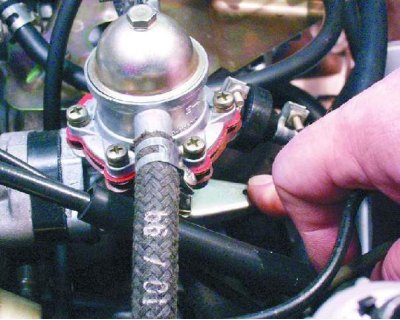
1. After a long stop, pump gasoline into the carburetor float chamber by pressing the fuel pump lever several times.
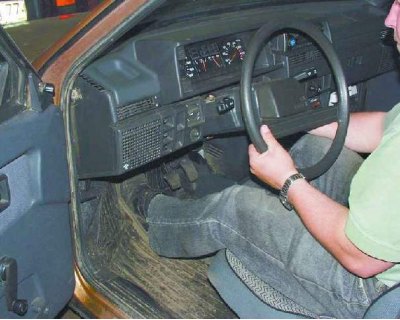
2. When the air temperature is below zero, press the clutch pedal all the way down and hold it while starting the engine.
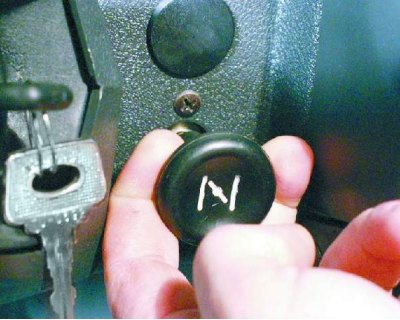
3. Pull the carburetor choke control fully towards you.
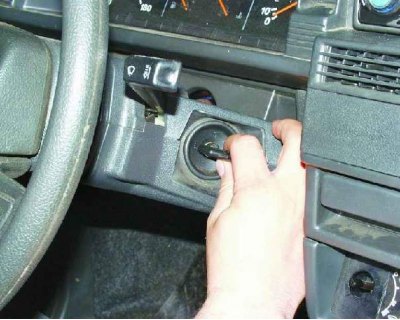
4. Turn on the starter by turning the key to position II (without pressing the accelerator pedal). Do not rotate the engine shaft with a starter for more than 10–15 s. If the engine has started, release the key - under the action of the return spring, it will return to position I.
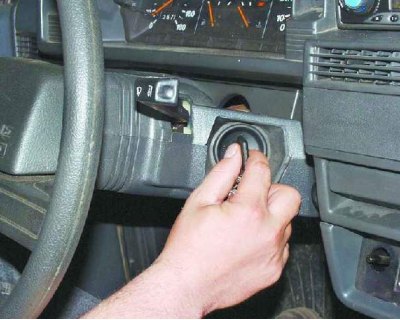
5. If the engine does not start on the first try, turn off the ignition by returning the key to position 0, and after 20-30 seconds, turn on the starter again.
6. If the engine is running steadily, gently release the clutch pedal (if she was squeezed).
7. As the engine warms up and the engine speed increases, gradually lower the choke control knob. In the warm-up mode, do not allow the engine to operate at modes above (2000±200) min–1.
Starting a cold carbureted engine equipped with an automatic starter
When the air temperature is below -25°C, press the accelerator pedal 2-3 times before starting the engine.
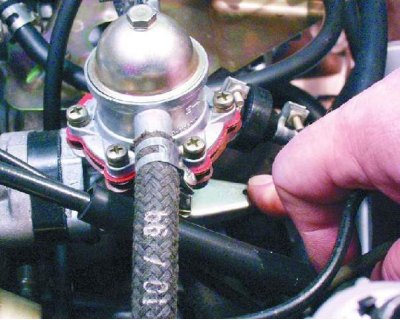
1. After a long stop, pump gasoline into the carburetor float chamber by pressing the fuel pump lever several times.
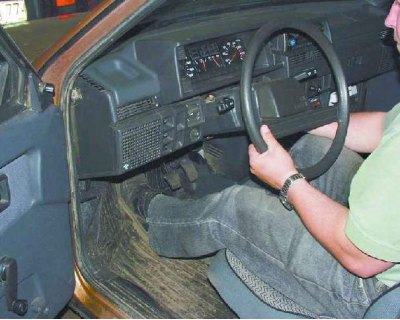
2. If the air temperature is below zero, fully depress the clutch pedal and hold it until the engine starts.
3. Press once on an accelerator pedal against the stop.
4. Turn on the starter by turning the key to position II (without pressing the accelerator pedal). Do not turn on the starter for more than 10–15 s. If the engine is running steadily, release the key - under the action of the return spring, it will return to position I.
5. If the engine does not start on the first try, turn off the ignition by returning the key to position 0, and after 20-30 seconds, turn on the starter again.
6. Slowly release the clutch pedal (if she was squeezed) with stable engine operation.
7. As the engine warms up, gently depress and release the accelerator pedal to reduce engine idle speed.
Warm engine start
Attention! When starting a warm engine, do not close the carburetor choke - this can lead to a re-enrichment of the combustible mixture and make it difficult to start.
1. Gently depress the accelerator pedal.
2. Turn the ignition key to position II, turning on the starter. Do not rotate the engine shaft with a starter for more than 10–15 s. If the engine is running steadily, release the key - under the action of the return spring, it will return to position I.
3. After starting the engine, release the accelerator pedal.
4. If the engine does not start on the first try, turn off the ignition by returning the key to position 0, and after 20-30 seconds, turn on the starter again. If after three attempts the engine does not start, check the ignition and power systems.
Hot engine start
Attention! When starting a hot engine, when the arrow of the coolant temperature gauge approaches the red zone, do not close the carburetor air damper - this will lead to a re-enrichment of the combustible mixture and make it difficult to start.
1. Depress the accelerator pedal about 1/3 of its travel and hold it while starting the engine.
2. Turn on the starter. Do not rotate the engine shaft with a starter for more than 10–15 s. If the engine is running steadily, release the key - under the action of the return spring, it will return to position I.
3. When the engine starts to run smoothly, gently release the accelerator pedal.
Starting the engine from the battery of another car
You will need:
- special wires for starting the engine from an external source
Attention! Check that the cars are not touching.
Attention! During start-up, do not touch the body.
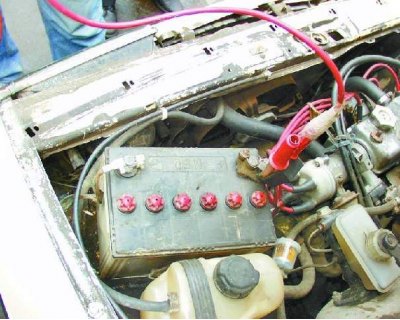
1. Connect the red wire to the terminal " " charged battery (on another car).
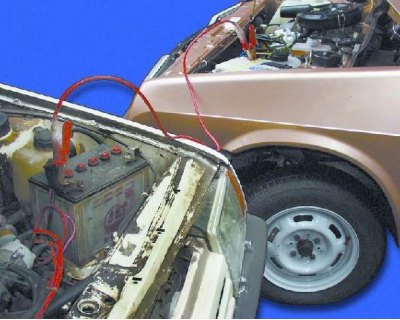
2. Connect the other end of the red wire to the terminal " " battery in your car.
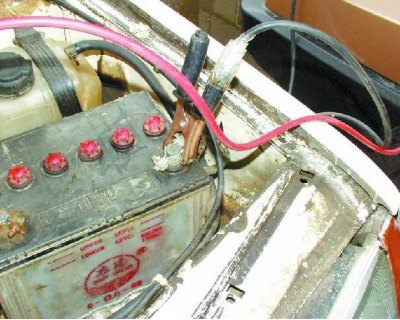
3. Connect the black wire to the terminal "—" charged battery (on another car).
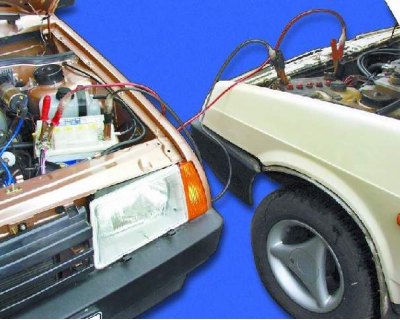
5. Start the car engine with a charged battery and let it run for at least one minute.
6. Try starting your car's engine. If the engine does not start, wait a few minutes and try starting again. After the engine has started, let it idle for a few minutes.
4. Connect the other end of the black wire to the terminal "—" battery in your car. Check that wires do not touch rotating parts (e.g. fan, alternator belt, etc.).
7. Stop the car engine with a charged battery.
8. Disconnect the wires in the reverse order of connection.
Starting the engine with a charger
You will require:
- charger-starter
Attention! If the battery is completely discharged, it must be recharged for 20–30 minutes before starting. A large inrush current from the charger can damage a fully discharged battery.
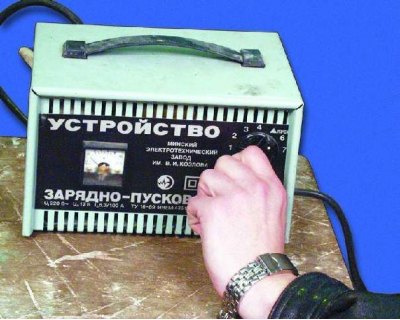
1. Move the charger to the position "START" in accordance with the manufacturer's instructions.
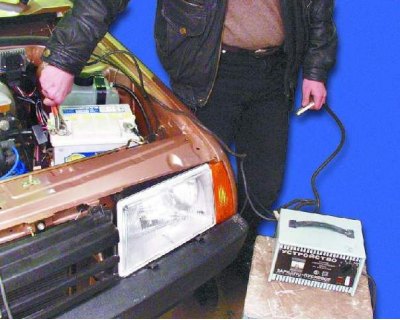
2. Connect the wires of the charger-starter to the battery terminals, observing the polarity.
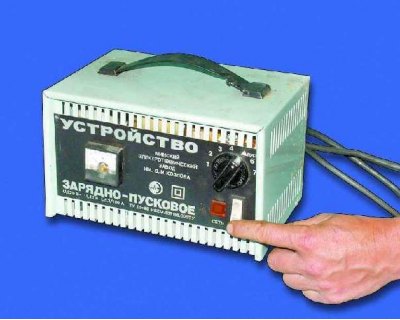
3. Turn on the charger.
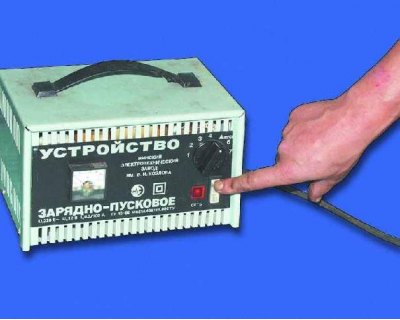
4. Start the engine. If the engine starts, first turn off the charger and starter, then disconnect its wires from the battery terminals.
